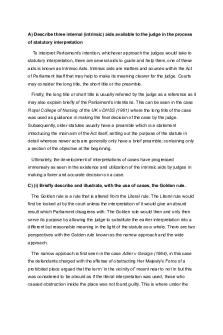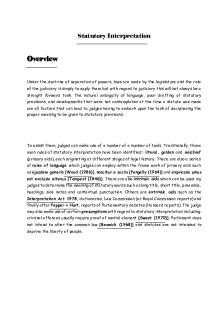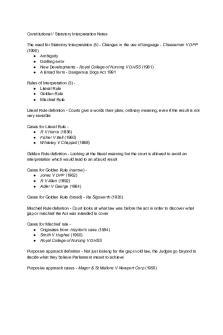Statutory Interpretation PDF

| Title | Statutory Interpretation |
|---|---|
| Course | Public law |
| Institution | University of London |
| Pages | 6 |
| File Size | 129.5 KB |
| File Type | |
| Total Downloads | 348 |
| Total Views | 852 |
Summary
Statutory InterpretationStatute is a written law passed by the legislative body, the Parliament, and is commonly known as the ‘Act of Parliament.’ Interpreting the meaning of legislation/statute is not always straightforward, regardless of the fact that draftsmen when drafting statutes try their bes...
Description
Statutory Interpretation Statute is a written law passed by the legislative body, the Parliament, and is commonly known as the ‘Act of Parliament.’ Interpreting the meaning of legislation/statute is not always straightforward, regardless of the fact that draftsmen when drafting statutes try their best to ensure that they draft legislation which is clear and unambiguous. There have been instances when statutes contained wordings with unclear and broad meaning making it difficult for the judge to interpret. Judges are required to interpret the statute using the Rules of Statutory Interpretation, which are:
The Literal Rule The Golden Rule The Mischief Rule, and The Purpose Approach
The Literal Rule: This approach requires the judges to interpret statute in its natural, clear and literal sense. This rule usually takes precedence over the others as it states that the words of statute should be interpreted to mean exactly what they mean, regardless of how absurd the conclusion maybe. As explained by Lord Esher MR in R v The Judge of the City of London Court case: ‘If the words of an Act are clear, you must follow them, even though they lead to a manifest absurdity. The court has nothing to do with the question whether the legislature has committed an absurdity.’ The literal rule does not questions the Parliament and thus upholds the basis of doctrine of Parliamentary supremacy, which further preserves the separation of powers. It limits the role of judges by not allowing them to make the law; and verdicts are based on facts and not opinion and prejudice. However, if the literal rule is used with rigidity then the loopholes in the Act might continue, until the Parliament realizes and changes it in due course. If an absurd conclusion is drawn from a statute then it clearly questions the intelligence of the judge interpreting the law.
An ancient example of the use of literal rule with an absurd outcome is the case of R v Harris, which involves interpreting an offence to “unlawfully and maliciously stab, cut and wound any person.’ Harris bit a nose of his friend and later finger of a policeman. The court held that Harris is not guilty of the crime as the law point towards the use of weapon and teeth are not considered a weapon. In London and North Eastern Railway Co v Berriman, a railway worker was knocked down and killed by a train, and his widow attempted to claim damages relying on a relevant statute. The statute provided that this was available to employees killed while engaging in ‘relaying or repairing’ tracks. The husband was doing routine maintenance and oiling, which according to the judgment of the court does not come within the meaning of ‘relaying and repairing.’ Meanwhile, a more recent case which shows how different judges in the same case interpret the meaning of a single word differently is R v Maginnis, which involved interpreting the “Misuse of Drugs Act 1971.” The law states: ‘it’s an offence for a person to have a controlled drug in his possession, lawfully or unlawfully, with intent to supply it to another…’ The police found a package of cannabis resin in the defendant’s car, to which he claimed that it belonged to his friend, who left it in the car, and is supposed to collect it later. Majority of the judges, deciding the case, applied the literal rule and held that the person left with drugs with an intention to return them, did have the intent to supply. However, Lord Goff giving a dissenting judgment held that the offence was aimed at drug pushers. The defendant is not a pusher, and should have been charged with a lesser offence of unlawful possession. R v Brown, which involved interpreting the “Data Protection Act 1984,” is another example which led to the difference of opinion of the judges interpreting the statute. The Act states: ‘It is an offence knowingly or recklessly to use personal data other than for the purpose described in the relevant entry in register of data users’ The police officer twice used the police national computer to check the registration of vehicles of debtor’s clients of his friend’s debt collection company. However, there was no evidence that he shared this data shared with his friend. Majority of the judges in this case applied the literal rule and held that no offence
has been committed as the data was only “accessed” and not “used.” Meanwhile, the dissenting minority adopted the point of view that the meaning of “use” should be used in a broader sense to achieve the purpose of the Act, which protection of citizens against the invasion of their privacy. In conclusion, many a cases like Whitely v Chapell, Fisher v Bell, where literal rule was applied, decisions were made which might have not given justice to the meaning of Act that it was intended for. In Stock v Frank Jones, Lord Simon advocated departure from literal rule only when: There is a clear and gross anomaly Parliament could not have envisaged the anomaly and would not have accepted its presence The anomaly can be obviated without detriment to the legislative intent The language of the statute allows for such modification.
The Golden Rule: The golden rule is described as a shadow or modification of a literal rule, where is applied to prevent absurdity and inconsistency if an Act is being interpreted literally. This approach encourages words in statute should be read in the context of a sentence as a whole, and then analyze what the Parliament was implying at the time of drafting the particular statute. The rule is applied in two ways: narrow and wide. In narrow approach, in case of an ambiguity in the meaning of the words, then the preference would be given to a word that does not give an absurd outcome. This was witnessed in Adler v George case. Under the Official Secret Act 1920, it is an offence to obstruct Her Majesty’s Forces in the vicinity of the prohibited area. Adler was arrested for obstructing the forces within the prohibited area. He argued that he was not in the vicinity of the prohibited area, rather he was inside the air base which is the prohibited area. Had the literal rule been applied, it would have produced an absurd outcome, as someone obstructing near the base would be committing an offence whereas someone obstructing inside the base
would not. While applying the Golden Rule, the court didn’t restrict itself to the literal wording of the Act and found Adler guilty. Under the wider approach, the courts are at the liberty to modify a word which only has one meaning in order to avoid an absurd outcome. In Re Sigsworth, a son murdered his mother and stood to inherit her entire estate as she had not left a will. Under the relevant Act of Parliament, the next of kin would inherit the deceased’s estate. The golden rule was applied, so that the son (next of kin) would not inherit the estate as he had killed the mother. The literal rule, in this case, would have produced an unjust result. The advantages of Golden Rule are the judgments are aligned with the statute and errors can modified before unjust and absurd precedents are set. Using logic while providing justice can help restore public confidence in the legal system. However, it can be concerning that this rule gives judges the liberty use to modify or change the meaning within the statute as per their discretion.
The Mischief Rule: The Mischief Rule is the oldest approach to the Statutory Interpretation and is applied to determine the intention of the legislator. The principle aims at finding the ‘mischief and defect’ in the statute and implementing a remedy for the case. This rule was established in Heydon’s case in 1584, where the court said four principles will be considered while interpreting the statute: 1. 2. 3. 4.
What was the common law before the rule was passed? What was the mischief that the law did not solve? What was the solution offered by the Parliament? What was the reason for the solution?
The Mischief Rule was applied in Corkery v Carpenter case. Under the “Licensing Act 1872,” it is an offence to be to be drunk in charge of a carriage. The defendant was charged for riding a bicycle under the influence of alcohol. The intention of the Act was to prevent an intoxicated person being in charge of transportation on a public highway. Although the Act did not refer to the bicycle, however, this rule was applied for the adaption of statute in the progressive society while closing the loopholes.
Smith v Hughes is another classic example of the use of mischief rule; where the approach of this rule is similar to the modern purposive approach. The case involves interpretation of the “Streets Offence Act 1959,” with a provision: ‘it shall be an offence for a common prostitute to loiter or solicit in a street or pubic place for the purpose of prostitution.’ The accused was tapping on window inside her house to attract the attention of a passerby. She argues that she was not “on the street.” Instead of adopting the literal approach, the court considered what ‘mischief’ the Act aimed at. Lord Parker CJ said, “it was an act intended to clean up the streets, to enable people to walk along the streets without being molested by the common prostitutes. While, looking at the second meaning in the words, he concluded that it was the ‘solicitation’ which must take place in the street, not the person who does the soliciting. The mischief rule is only applied to determine the mischief and defect that the statute was intended to remedy. However, the drawback from this rule could be that like golden rule, this also gives judges the law-making authority, which further infringes on the separation of powers. Judges could make decisions based on their own discretion which could lead to biased judiciary.
The Purposive Approach: This approach is implemented to ensure the effectiveness of law as Parliament would have intended. It encourages the judges to look for the ‘spirit of the Act’ and to read words into or out of the Act, when necessary. This approach is mostly used when interpreting EU laws. In Pickstone v Freeman, Mrs. Pickstone brought a case against her employer under the Equal Pay Act 1970. She worked as warehouse operative and given the equal pay as her male counterparts. However, she claimed that job of a warehouse checkers is the same as hers and the male checkers get 1.22 pound more every week. The court decided that adopting literal approach of the Act would lead to the breach of the EU treaty, and therefore used the purposive approach by giving the judgment in Mrs. Pickstone’s favor. In conclusion, the judges are always seeking to give effect to Parliament’s intentions, regardless of whatever approach they take to statutory interpretation. Some judges stay close to the words of statue by adopting literal approach, while
some feel the need to give effect to Parliament’s intention by understanding the purpose of the legislature....
Similar Free PDFs

Statutory Interpretation
- 6 Pages

Statutory Interpretation
- 6 Pages

Statutory Interpretation
- 3 Pages

Statutory Interpretation
- 5 Pages

Statutory Interpretation
- 11 Pages

Statutory Interpretation
- 6 Pages

Statutory interpretation notes
- 2 Pages

Statutory Interpretation 70102
- 5 Pages

Statutory Interpretation in Malaysia
- 12 Pages

Statutory Interpretation Notes
- 9 Pages

Statutory Interpretation Notes
- 4 Pages
Popular Institutions
- Tinajero National High School - Annex
- Politeknik Caltex Riau
- Yokohama City University
- SGT University
- University of Al-Qadisiyah
- Divine Word College of Vigan
- Techniek College Rotterdam
- Universidade de Santiago
- Universiti Teknologi MARA Cawangan Johor Kampus Pasir Gudang
- Poltekkes Kemenkes Yogyakarta
- Baguio City National High School
- Colegio san marcos
- preparatoria uno
- Centro de Bachillerato Tecnológico Industrial y de Servicios No. 107
- Dalian Maritime University
- Quang Trung Secondary School
- Colegio Tecnológico en Informática
- Corporación Regional de Educación Superior
- Grupo CEDVA
- Dar Al Uloom University
- Centro de Estudios Preuniversitarios de la Universidad Nacional de Ingeniería
- 上智大学
- Aakash International School, Nuna Majara
- San Felipe Neri Catholic School
- Kang Chiao International School - New Taipei City
- Misamis Occidental National High School
- Institución Educativa Escuela Normal Juan Ladrilleros
- Kolehiyo ng Pantukan
- Batanes State College
- Instituto Continental
- Sekolah Menengah Kejuruan Kesehatan Kaltara (Tarakan)
- Colegio de La Inmaculada Concepcion - Cebu




